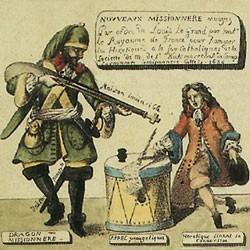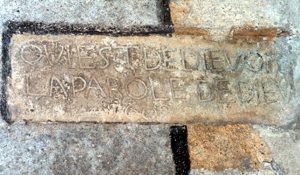The Cevennes area after the Revocation
Submitted to the Dragonnades, the Protestants, who were a majority in the Cévennes area, massively abjured. After the Revocation the remaining Protestant churches were destroyed and the pastors left France. But most of the so-called new converts tried to keep compulsory catholic worship to a minimum.
A period of underground activity had thus started. Those who had managed not to abjure secretly met with the others in small groups, in isolated places for the forbidden service of worship. The services were led by “lay preachers” who preached and sometimes celebrated the Holy Communion. The most famous of them were François Vivent and Claude Brousson.
Nicolas Lamoignon de Basville, the king’s administrator in Languedoc from 1685 to 1718, tracked down the secret meetings. Preachers were killed, worshippers jailed or sentenced to the galleys or massacred.
The first uprising planned in the Cevennes
At François Vivent’s prompting, worshippers at assemblies would bear arms for their defence in case of attack by the king’s dragoons. Basville accused preachers of rebelling against the king and, as a result, intensified repression.
François Vivent then contacted the Protestant princes at war with Louis XIV during the war of the Augsburg league (1689-1697). He asked for their support in forcing Louis XIV to restore the Edict of Nantes.
He had great hopes in William of Orange who had recently become the King of England (1688-1689). The latter made several plans to land in the Bas-Languedoc region, while François Vivent was leading of the uprising in the Cévennes region.
But these plans were never put into practice, and no account was taken of French Protestants by the Protestant countries at the Ryswick peace in 1697.
"Prophetism"
One after the other the preachers were killed, Vivent in 1692, Brousson in 1698. In 1699 Roman, the last preacher, was made prisoner but he managed to escape to Switzerland. Preaching then took a new aspect, that of prophetic inspiration. The prophetic movement appeared in the Dauphiné and Vivarais regions before spreading to the Cévennes in 1700.
“Repent, do not go to mass, forsake idolatry” (« Repentez-vous, n’allez plus à la messe, renoncez à l’idolâtrie »)… such were the basic watch-words of the prophets who heralded the on-coming destruction of the Beast in the Book of Revelations, i.e. the Roman catholic Church. The prophetic preaching was uttered with a trembling and tearful voice by women, children, humble craftsmen, peasants.
Important city dwellers would not take sides, and feared this highly confused charismatic outburst. So did the pastors of the Refuge movement, except for Jurieu.
Meanwhile Basville kept on imprisoning people.












